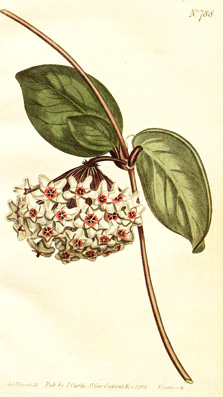Hanging in There with Hoyas
By Audrey Stallsmith

Most hoyas are obstinately persistent plants. You can scarcely kill them.
Tovah Martin, The Essence of Paradise
When bringing my tropical plants indoors for the winter, I always plunk the dangly hoyas down on a north-facing windowsill because they are among the few plants which can thrive under such conditions. In fact, they are more likely to bloom if treated poorly and kept pot bound in indirect light under somewhat dry conditions.
Related to milkweeds and called wax plants for their glossy leaves and flowers---or sometimes honey plants for the drop of liquid at the center of each flower---hoyas grow slowly and may take years to come into bloom. Their waxy “stars within stars” are so perfectly shaped that the plant stands for “sculpture” in the Language of Flowers.
Introduced to the gardening world at the beginning of the 1800s, hoyas originated in tropical Asia and Australia, with most types being hardy only in USDA zones 10 and 11. They were named for gardener Thomas Hoy, who grew hothouse plants for the Duke of Northumberland in the late 1700s and early 1800s. The most popular species, carnosa, means “fleshy.”
Cuttings from hoyas will root easily if allowed to dry out for a few days before being potted up. Even leaves will root easily, but I found out the hard way they may just sit there and make no effort to send out further shoots. So be sure that you root a piece of stem rather than leaves.
When my plain-leafed hoya blooms, it does so while on the front porch during the summer months. My variegated one has yet to flower, but is worth growing just for its colorful foliage. Be careful that you don’t remove the flower "stems" after the flowers drop off, because the plant makes new flowers on the same “spurs” the following year.
Yes, the never-in-a-hurry hoya may “hang tough” for several years before it rewards you with blooms. But you can rest assured that it won’t be much trouble in the meantime!
Hoya carnosa image is from an 1805 issue of Curtis's Botanical Magazine, courtesy of plantillustrations.org.








